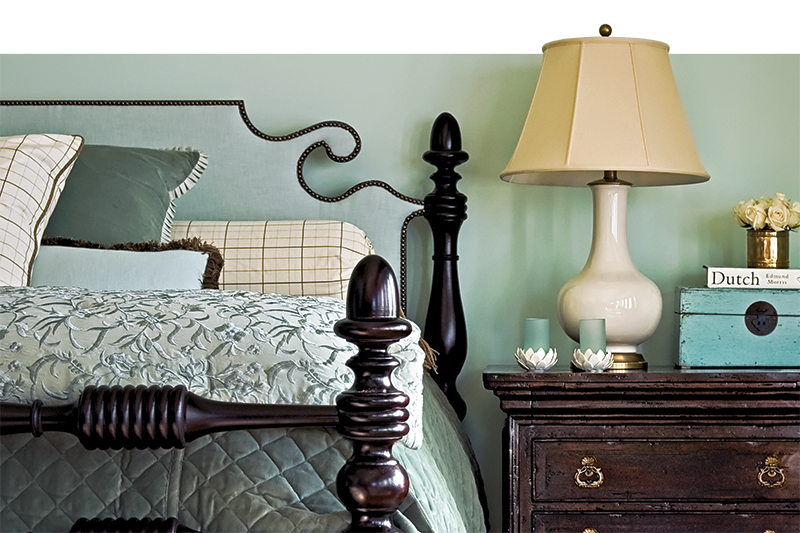We spend a lot of time in our bedrooms – almost one-third of our lives, in fact – so it’s important to make sure our bedrooms are conducive to a good night’s sleep. Why, you ask?
“Sleep affects almost every tissue in our bodies,” says Dr. Michael Twery, a sleep expert at NIH. “It affects growth and stress hormones, our immune system, appetite, breathing, blood pressure, and cardiovascular health.”
Our bedrooms often contain harmful toxins that can disrupt sleep and negatively impact our health. It has become increasingly recognized that the quality of our sleep is linked to our health. The good news is that we can take these simple steps to create a sleep sanctuary – a non-toxic, healthy bedroom optimal for sleep and relaxation. By making simple changes to our bedrooms, we can enjoy deeper, healthier sleep and improve our overall health and well-being.
Here are some easy ways to create a sleep sanctuary in your bedroom right now:
- Control the temperature. Keep your bedroom cool (60–67° Fahrenheit) to promote a comfortable sleep environment.
- Reduce electronic devices. Remove any electronics from your bedroom, including televisions, laptops, and smartphones. Not only can they emit harmful EMFs (electromagnetic fields), but they can also disrupt your sleep by emitting blue light. If you must have electronics in your bedroom, turn them off at least an hour before bedtime.
- Manage the light in the bedroom during sleeping hours. Our natural circadian rhythm, our internal 24-hour clock, regulates our alertness and sleepiness by responding to light changes. You need darkness to turn on that sleepiness and get a good night’s sleep – and a whole night’s sleep!
- Declutter your space. Keeping your bedroom free of clutter can promote relaxation and reduce anxiety levels.
- Vacuum and damp mop and dust regularly. This will reduce the toxins caught in the space that you’ll breathe in when sleeping.
- Use organic, non-toxic, clean solutions when washing your sheets, and take all synthetic air fresheners out of the space. Fragrance ingredients can aggravate sinus conditions, trigger asthma attacks, and cause headaches and eye, nose, and throat irritation, which do not help create a calm sleeping environment.
- Open your windows to bring fresh air in, and run an air filter to clean the air when your windows are closed.
Thinking about Renovating or Redecorating Your Bedroom?
Here are some things to keep in mind:
- Use a no-VOC primer and paint. Primer is essential, as it will create a base to encapsulate any off-gassing from previous wall paint or treatments, followed by no VOC paint. The walls and ceiling are the most significant surface of your room, and if not treated properly, it will greatly impact the air quality.
- Consider getting a non-toxic mattress. There are many options on the market at many price points. I counsel my clients to pick the most non-toxic they can afford. You want to check that no chemicals, such as petroleum-based foams and chemical flame retardants, are used in construction. These are common irritants in people with chemical sensitivity and compromised respiratory systems and can also build up in our systems and be endocrine disruptors which can negatively affect our health. This applies to pillows, too – look for those made from natural materials such as buckwheat or wool or a certified nontoxic fill.
- Choose non-toxic bedding and pillows. Invest in organic cotton or bamboo sheets. Synthetic bedding can emit harmful chemicals that can negatively impact your health and disrupt your sleep. It’s also essential to ensure that your bedding is appropriate for the season – lightweight fabrics in summer and heavier blankets in the winter.
- Invest in blackout curtains or blinds. Light pollution from streetlamps, car headlights, and even moonlight can disrupt your natural circadian rhythm and impact your ability to fall asleep. Blackout curtains or blinds can also help reduce noise pollution. I stick to natural materials for window covering; if I use fabric, I look for organic or certified materials. If you use a wood blind or similar, they should have a non-toxic finish or paint. This eliminates the off-gassing of these materials.
- Consider incorporating calming decor, such as soft lighting, essential oil diffusers, or a Himalayan salt lamp.
- Add live plants for a connection to the outdoors, and these plants can clean our air naturally.
By making these simple changes, you can transform your bedroom into a sleep sanctuary – a healthy, non-toxic environment that promotes restful, rejuvenating sleep. Self-care starts where we sleep.
Carolyn Tierney, CSBA, GREENleader AP, is a Holistic Interior Designer and Wellness Specialist. Ms. Tierney guides families seamlessly through the design experience, from construction to decoration, creating a non-toxic and stylish home. She leads studios in Simsbury, CT, and New York City.
Contact at 929.390.1742, info@carolyntierney.com, www.CarolynTierney.com.
